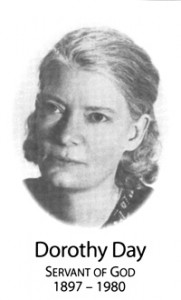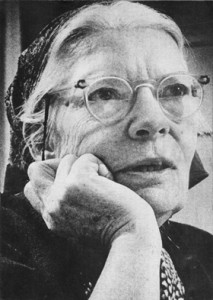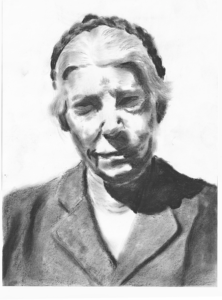 Hello, and greetings from the Dorothy Day Guild! You might know that we received a really important canonization update last month: the Dicastery for the Causes of Saints in Rome appointed Monsignor Maurizio Tagliaferri as the relator for Dorothy’s cause! Our Guild steering committee, George Horton, Deirdre Cornell, and Dr. Kevin Ahern, met with our postulator, Dr. Waldery Hilgeman, at the beginning of November, when he shared this news. This was a great gift for Dorothy’s birthday on November 8th and her anniversary of death on November 29th! All of us here at the Guild are thrilled with this development, and we wanted to take this opportunity to explain what happens at this stage of the canonization process and outline the next steps towards sainthood for our members.
Hello, and greetings from the Dorothy Day Guild! You might know that we received a really important canonization update last month: the Dicastery for the Causes of Saints in Rome appointed Monsignor Maurizio Tagliaferri as the relator for Dorothy’s cause! Our Guild steering committee, George Horton, Deirdre Cornell, and Dr. Kevin Ahern, met with our postulator, Dr. Waldery Hilgeman, at the beginning of November, when he shared this news. This was a great gift for Dorothy’s birthday on November 8th and her anniversary of death on November 29th! All of us here at the Guild are thrilled with this development, and we wanted to take this opportunity to explain what happens at this stage of the canonization process and outline the next steps towards sainthood for our members.
Our Guild has benefited from years of guidance and support from our postulator in Rome, Dr. Waldery Hilgeman, and he graciously shared a lot of background information on this stage in the process when he met with our steering committee last month. Two years ago, on December 8th, 2021, the diocesan phase of the canonization process formally concluded when the boxes of material evidencing Dorothy’s holiness were sealed at a celebratory mass at St. Patrick’s Cathedral in New York and sent to the Vatican. Over the summer, we learned that the Dicastery for the Causes of Saints officials had completed the first review of the materials we sent them and had given their stamp of approval on the work completed during the diocesan phase of the canonization process– a significant hurdle to pass, indicating that the transcriptions, testimonies, and eye-witness interviews had all been conducted according to the juridical norms of the Dicastery. Since then, we have been eagerly awaiting news that the relator, the person appointed by the Dicastery to provide a thorough and objective report on the life, virtues, and reputation of holiness of the individual being considered for canonization, has been appointed.
The Role of the Relator:
The relator has a few key duties, all of which contribute to ensuring that the process of canonization is thorough, fair, and in accordance with the established procedures of the Dicastery. His primary work is in the compilation of the positio, which is a comprehensive, detailed account of Dorothy’s life, virtues and holiness. As our postulator, Dr. Hilgeman and his team will continue to work closely with Monsignor Tagliaferri in the preparation of the positio. This document serves as the basis for further discussion and evaluation with the larger body of the Dicastery. In order to put this document together, the relator is responsible for analyzing the results of the diocesan inquiry, which we concluded two years ago when we sent our boxes of evidence to Rome. Right now, this is what Monsignor Tagliaferri is working on for our cause. During our advisory committee meeting in June, Dr. Hilgeman shared with us some of his hopes for the type of person who would be appointed as our relator for Dorothy’s process. Dr. Hilgeman told us that finding the right person for the job sometimes takes months because the saints are so diverse in their particular expressions of sanctity, their historical contexts, and their linguistic and cultural backgrounds. The relator’s contribution to this stage of the canonization process is in ensuring the accuracy of the factual narrative of the candidate’s life and accuracy in the historical details of the candidate’s time and place. In our case, we needed a relator who was able to write and conduct research in English, and who was familiar with the nuances of American culture and the social, economic, and political landscape of the mid-twentieth century. In short, we needed someone who would understand Dorothy, and as you know, she is not an easy figure to categorize! We are so pleased with the selection of Monsignor Tagliaferri, who has worked on a number of other American sainthood causes that are dear to many of our members, including two of the Saintly Six Black American “Saints in Waiting,”Venerable Augustus Tolton and Servant of God Julia Greeley. All of us at the Guild feel that Dorothy’s cause is in capable and devoted hands.
Much of the relator’s work involves research, so if necessary he may request further collection of historical documents, testimonies and any other relevant evidence. Monsignor Tagliaferri will also work closely with theologians, historians, and other experts to ensure that the positio is accurate, thorough, and in accordance with the theological and canonical requirements for canonization. As a journalist whose career spanned six decades and a lifelong diarist, Dorothy’s body of written work is extensive, and because of this, the compilation of her positio may take longer than that of a less-literary saint. Many of us who are eager for her canonization feel blessed by the level of insight that this quantity of writing provides us into her life and legacy while occasionally wishing that she had been briefer in print! Eventually, upon completion, Monsignor Tagliferri will present Dorothy’s positio to the theological and historical consultors and the members of the Dicastery for the Causes of Saints, and make a clear and reasoned case for her canonization. Monsignor Tagliaferri will participate in the discussions and deliberations of the Congregation, offering insights and responses to questions raised by other members and giving his recommendation for her beatification and eventual canonization. Once the positio has been accepted by the Dicastery, Pope Francis may declare Dorothy “Venerable,” the next official stage in the canonization process.
Collaboration with our Postulator:
As the postulator for Dorothy’s cause, Dr. Hilgeman is our advocate in Rome. We’ve used the phrase “canonization process” in Guild newsletters and publications; declaring someone to be a saint is a ‘process’ in the legal sense of the word. Dr. Hilgeman is a canon lawyer, and his close collaboration with Monsignor Tagliaferri ensures the entire process aligns with the established legal and canonical requirements for beatification and eventually canonization. While the relator’s role is focused on historical and factual details of the candidate’s life, Dr. Hilgeman’s task is to present a compelling case for Dorothy’s sanctity, often focusing on the theological and pastoral dimensions of her witness to the Gospel. Throughout this stage of the canonization process, Dr. Hilgeman and Monsignor Tagliaferri will collaborate on research using the evidence gathered during the diocesan phase. As our advocate, Dr. Hilgeman will also work closely with the Dorothy Day Guild, gathering accounts of the widespread devotion to Dorothy among various Catholic communities in the United States and globally, as well as any accounts of special graces and favors you may have received while praying through Dorothy’s intercession. Waldery will continue to engage with the theologians, historians, doctors, and other experts who are charged with evaluating Dorothy’s case in order to provide a well-rounded perspective on her life, virtues, and reputation for holiness and will stay in close contact with the Dicastery, offering support and clarification to those who will be in charge of making recommendations on Dorothy’s cause in the future..
What Comes Next?
While we don’t know exactly how long it will take for Monsignor Tagliaferri, Dr. Hilgeman, and their team to complete the positio, the stage of the canonization process that we are in now, from the beginning of the Roman phase of the cause to the moment where the candidate is declared Venerable, typically takes between two and five years. Since the Roman phase began when the evidence of Dorothy’s sanctity was delivered to the Vatican two years ago, we hope that this moment is coming within the next three years. Once the positio has been officially submitted to the Dicastery, it undergoes an examination by nine theologians who vote on whether or not Dorothy lived a heroic life. According to the USCCB, “If the majority of the theologians are in favor, the cause is passed on for examination by cardinals and bishops who are members of the [Dicastery].” If these cardinals and bishops vote yes, the head of the Dicastery presents the results to Pope Francis, who can then give his approval and authorize the Dicastery to draft a decree declaring Dorothy Venerable.
Here’s how you can help: keep praying! We need your prayers at this stage of the cause more than ever. Pray for Dorothy’s canonization, and especially pray through her intercession, asking her to bring your needs and the needs of our world to Christ. It is a HUGE help to Dr. Hilgeman.
Houston Catholic Worker, January-March 2024, Vol. XLIV, No. 1.



